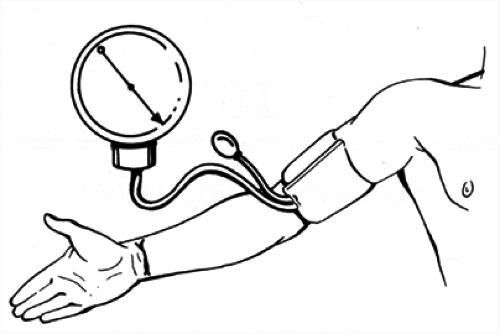Arterial Injuries
General Information
Significant redundancy exists in the vascular supply to the upper extremity. The brachial artery has radial and ulnar collateral vessels at the elbow. The radial and ulnar arteries form a parallel inflow system that may be accompanied by a deep interosseous artery in the forearm. Two palmar arches supply the wrist and hand. Each digit has two palmar arteries and a variable dorsal outflow system. These vessels are superficial at the medial elbow, distal volar forearm, and palmar aspect of the digit. Lacerations that violate the fascia at these levels should lead to suspicion of arterial injury even if inflow exists. Arteries have muscular walls, which decrease blood loss by going into spasm when injured. This same property retracts the cut ends of the vessel from the zone of injury making the diagnosis more difficult. In contrast, partially injured vessels, especially those with longitudinal tears, may bleed freely and present with ongoing pulsatile blood loss.
Diagnostic Criteria
Patients with arterial injuries distal to the elbow may present as lacerations with sudden, dramatic blood loss and distal ischemia. These injuries are not difficult to diagnose and require prompt treatment to minimize tissue loss and systemic complications. Patients with these injuries may also present more subtly with a laceration or puncture, which bleeds briefly, then stops. A high index of suspicion and complete workup confirm the diagnosis and prevent late symptoms of pain, exercise, and cold intolerance, or even tissue loss.
Emergency treatment of arterial bleeding involves control of the blood vessel. Distal to the elbow, direct pressure over a lacerated vessel generally controls blood loss. This is initially applied as direct pressure and later supplemented by a compressive bandage. In severe cases, a pneumatic tourniquet or blood pressure cuff inflation proximal to the injury stems blood flow. Cuff pressure should be 50 to 100 mm Hg above systolic blood pressure (Fig. 1). These injuries require emergency evaluation by a specialist who can undertake arterial repair.
Random probing and clamping in uncontrolled bleeding may lead to nerve injury because nervous and arterial structures lie in close proximity to each other throughout the forearm and hand.
Random probing and clamping in uncontrolled bleeding may lead to nerve injury because nervous and arterial structures lie in close proximity to each other throughout the forearm and hand.
 FIG. 1. The use of a pressure cuff to control bleeding. This method can be used to temporarily control bleeding while additional evaluation and emergency consultation is obtained.
Stay updated, free articles. Join our Telegram channel
Full access? Get Clinical Tree
 Get Clinical Tree app for offline access
Get Clinical Tree app for offline access

|




